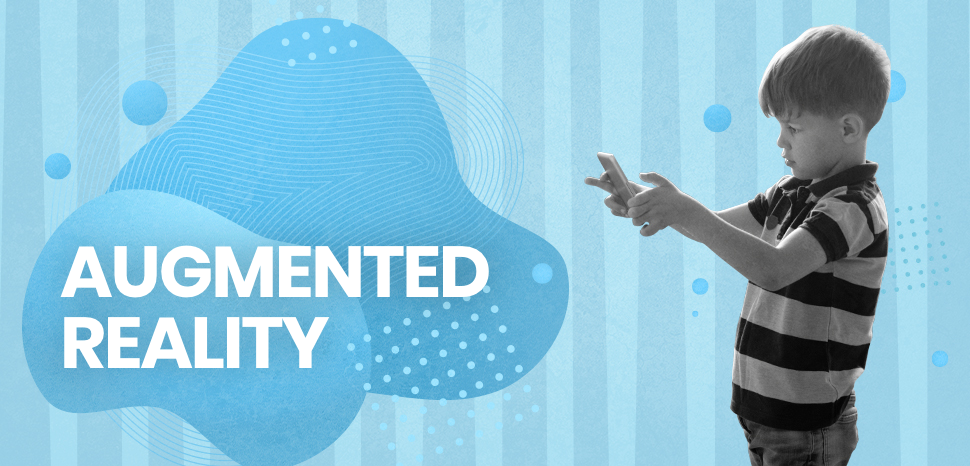The future of eCommerce: part 3

Article topics
- What is AR?
- Why AR in eCommerce?
- AR applications
- Engagement and loyalty
- The sound of AR
- AR glasses
- Shared AR experiences
- A risky proposition?
- Mainstream AR is coming
- Final thought
The potential benefits offered by augmented reality (AR) can give consumers significantly richer and more valuable shopping experiences. Yet although AR has been touted in recent years as the next big thing in shopping, the reality has so far not matched expectations. Although we have talked about AR before as a component of mcommerce, this article takes a deeper dive into AR.
What is AR?
AR is where a real-life environment is combined with digitally created content, such as text, images, animations and video, that behave as though they are part of the real-world. AR is often talked about in similar terms as virtual reality (VR) but is not the same thing. VR is a totally immersive experience that ‘replaces’ the real world, whereas AR is partially immersive, adding to or enhancing a real-world environment, blurring the boundary between real and digital.
AR can be experienced using a phone or tablet, viewing the augmented world on-screen through the device’s camera. You may be familiar with AR from the gaming world: Pokémon Go, Knightfall AR, The Walking Dead: Our World etc. These games superimpose digitally generated characters and environments onto the real-world to interact with during game play.
AR can also be experienced using a headset in specific applications, such as in museums and galleries, and for education and training purposes. Whilst useful in these particular situations, a headset is not practical as a wearable for mainstream personal use (more on that later).

Why AR in eCommerce?
eCommerce has been growing year on year for the past decade, with online sales in the UK this year expected to be worth £20 billion and nearly £2.5 trillion worldwide. With more and more people shopping online, with growing competition and the growing fickleness of consumers, brands and businesses are constantly looking for ways to reduce friction in the path to purchase and offer consumers and customers outstanding UX and CX.
Most products are sold online. But selling some items online can be problematic, in the sense that it can be difficult for consumers to visualise what a product is like from just generic images and video (Will it suit me? How will it feel? Will it work in my situation?). This can cause problems for businesses and brands with conversion rates and returns as consumers are put off buying or do buy and find the item was not quite what they were expecting, entering businesses into a time consuming and potentially costly returns procedure.
AR empowers consumers to make more informed choices about what they buy. It also helps engage consumers with more relevant and valuable shopping experiences.
AR applications
AR provides a way for consumers to remotely visualise and get a better sense of a product, by placing an item in context, in real time, on screen, whether it’s clothing, makeup, home furnishings, etc. The ability to digitally ‘try before you buy’ can give consumers the confidence to purchase, increasing conversion.
AR is being adopted by brands such as Goat, who sell rare trainers online. They offer consumers an AR try before you buy experience. This enables consumers to see what trainers look like on—this is helpful, given that they are relatively high-ticket items.

Another example is the Dulux Visualiser app, which lets you see how different paint colours will look in your home, to get a better idea of how it will work with furniture and floors etc.

It’s not just online where AR enhances shopping experiences. While shopping in the real world, AR can guide consumers to different stores by using digital signposts that tell them at a glance what a store sells, give review information and even special offers in real time. Inside brick-and-mortar stores AR can give consumers information about a product: where it was manufactured, when it was produced etc. For grocery shopping AR can give additional information such as nutritional values and calorie count for a whole shelf, without the consumer having to read the small print on every item.
Engagement and loyalty
Because AR gives consumers richer shopping experiences, with try before you buy and easier access to product information, it increases engagement. Consumers that are able to interact on a deeper level with the products and brands that interest them will be more likely to trust you compared to brands and businesses that don’t offer that level of engagement.
Better engagement leads to more fluid and satisfying experiences. Brands and businesses that offer consumers more value is more likely to inspire loyalty. Future AR offers the possibility to personalise real world shopping experiences. In the same way that shopping online can be highly personalised, AR will enable that level of personalisation in an augmented world. The information and messages about products in an AR store will instead of being generic, be tailored to individual consumers, with personalised special offers linked to CLV, related product recommendations linked to previous purchases (on and offline) and even virtual personal shopping assistants.
The sound of AR
The focus has so far been on AR as a visual experience. But what about hearing? For a fuller AR experience its logical to incorporate audio. To be able to hear AR offers another level of emersion and engagement. Apple AirPods and similar earbuds will enable consumers to hear audio such as virtual shopping assistants and mood music, as well as enabling partially sighted and blind people to benefit from AR.
One issue with using earbuds for AR is that it can block sound from the real world. As AR technology advances, audio will be integrated to visual wearables such as AR glasses, giving consumers a more seamless AR experience.

AR glasses
Some AR requires a headset rather than using your phone or tablet. Whilst headsets are practical in some settings, such as a gallery, museum or for educational and training needs, they are too heavy and cumbersome to be practical for personal, everyday use. Apple is taking a lead on the development of AR wearables as the technology is evolving.
But for eCommerce, the idea of consumers popping on their AR glasses as they enter a shopping area or retail store to take advantage of personalised AR experiences is, at the current rate of development, some years away—lightweight AR wearables aren’t expected to be available before 2023. However, it is the logical conclusion, and as more consumers become aware of and grasp the benefits of AR, the drive to develop unobtrusive AR wearables will grow.
Shared AR experiences
AR is at the moment mainly a lone experience. But as technology evolves AR will enable consumers to share shopping experiences, either in person or on social media. Imagine shopping online for a new jacket, but you can’t make up your mind which one you like best. Shared AR will enable you to try them on while your friends across town, in another city or another country help you decide, in real time, while having fun and socialising. Combined with mcommerce, this becomes a powerful idea: shopping with friends on social media without having to leave the platform to visit a webstore.
Group AR in theme parks, galleries and museums will enable consumers to share experiences. It will empower learning as teaching and training can be enhanced to visualise complex concepts and processes.
A risky proposition?
Implementing AR is a significant investment for businesses and brands, both on and offline. And with AR technology still being developed, it’s easy to see why it’s still viewed as niche. While AR games are popular, consumers are not yet expecting or demanding AR shopping.
AR is for many consumers still a bit of a gimmick and they don’t yet see how it could enhance their shopping experiences with practical and valuable application. As demand grows and technology develops, businesses and brands will be more willing to invest.

Mainstream AR is coming
Research shows that in 2019 only 21% of consumers in the US regularly use AR. This is a relatively high percentage, but considering that AR has been around for a few years, it suggests that adoption so far is slow. However, as lightweight AR glasses, with audio and phone capability, become available at affordable prices, consumers will begin to take more notice.
The next generation of consumers, Gen Z, is more likely to be receptive to new technologies, such as AR shopping, especially in the real world as they are less likely to make a distinction between online and offline. Combine this with the recent arrival of 5G and the increasing connectivity that it will bring, and other drivers, such as AR in education, for training and as a user interface in its own right, and the future for eCommerce AR looks bright, as consumers begin to see AR being successfully applied in other areas.
Final thought
While AR has been slow to take off there is little doubt that it’s coming and will have a significant impact on how we shop. But as with any new technology, it remains niche for a while before becoming mainstream, and that shift into the mainstream is always driven by consumer demand.
AR is part of the ongoing change in the way we shop, and together with headless commerce, mcommerce and omnichannel, it will help businesses and brands rise to the challenges of a shifting retail landscape and the convergence of digital and real world shopping.


 Back
Back
